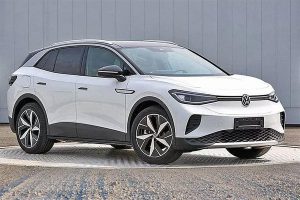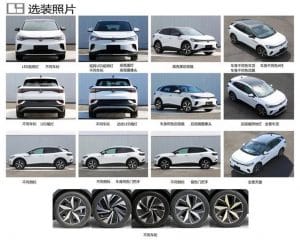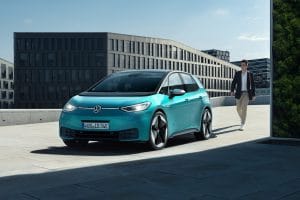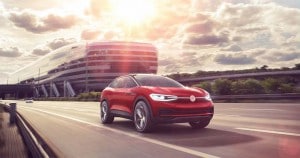Volkswagen is planning to launch a blitz of new, all-electric vehicles between now and mid-decade, the little ID.3 unveiled last fall set to be followed soon by the ID.4 SUV that will become VW’s first long-range model targeting the U.S. market.
While the German automaker was set to reveal the ID.4 later this summer, it seems that folks at the Chinese Ministry of Industry and Information Technology were getting impatient. Intentionally or not, the government have leaked out and provide a clear indication of what Volkswagen has coming.
The images show just how much the design picks up from both the ID.3 hatchback and ID Crozz concept, as well as the ID Space Vizzion prototype revealed last November at the Los Angeles Auto Show.
One big surprise, if your vision is sharp enough, is the appearance of the name, “Crozz,” embossed on the back bumper in one of these shots.
(For more on the ID.4, Click Here.)
The electric SUV is based off the same MEB architecture that will be used for the vast majority of all-electric models the Volkswagen Group plans to bring to market by 2025. As has become the norm, batteries and motors will be mounted below the floorboards, yielding more interior space than the modest footprint might otherwise suggest.
Though larger than the ID.3 hatchback, the ID.4 still slips into the compact category where it will go up against other mainstream battery-electric vehicles such as the Tesla Model Y, as well as the Hyundai Kona EV.
With no engine up front, the nose of the ID.4 is shorter than one would expect if it were using internal combustion power. While not apparent in any of these shots, a front-mounted trunk, or frunk, is all but certain.
(VW making major investment in breakthrough solid-state batteries.)
A slim chrome bar links the twin LED slit headlamps and, one readily notices, there’s no conventional front grille, reflecting the lower need for airflow in an EV, the emphasis shifting to lowered wind resistance. Some air is needed to cool all the electrical and electronic components, and there’s a modest under-bumper, crosshatch grille, as well as twin scoops framing the bumper, likely used for air curtains meant to reduce wind turbulence around the front wheels.
The main picture, showing the ID.4 at a ¾ front angle, reveals distinctive, blade-like alloy wheels, but the second image shows that buyers will have a number of different wheel options to select from.
The overall look is stylish, a rising beltline countered by the sweep of the coupe-like roofline.
Beyond the near lack of a grille and the unusually short hood, there is little about the ID.4 that would immediately tell someone that this is a battery-electric vehicle. Audi took a similar approach with its first long-range model, the e-tron SUV, though company officials say they’ll adopt a more distinctive look for future e-tron models.
What to make of the “Crozz” badging? According to EVPartner.com, the website that tracked down these images, it appears there will be at least two variants of the ID.4 available in China. We’ll have to wait to confirm if the same approach will be taken in the U.S.
(Check out the all-new version of the VW Golf GTI.)
We may yet see VW pick up a trick from Tesla and offer multiple battery pack options. VW officials have hinted they’re targeting an EPA range of around 250 to 300 miles with the ID.4, numbers that are in line with what potential buyers are saying they now expect. The original version of the Audi e-tron was hammered by critics for its marginal range of barely 200 miles per charge.
As for pricing, Volkswagen of America CEO Scott Keogh suggested last autumn in Los Angeles that he’s looking for something in the low to mid-$30,000 range. That’s before a $7,500 federal tax credit. And that could give VW a leg up on Tesla which saw its own federal incentives phase out last year and vanish entirely on January 1, 2020.
Considering their different regulations, we yet could see differences between the Chinese and American versions of the VW ID.4, but we’d expect those to be minor, at the most.





I want to order the I’d crozz as shown in red not a I’d 4 crozz if they are 2 different cars please can you advise me if it is going into production with side cameras not mirrors and will it have sliding front doors and possible time to pay a deposit Thanks Terry James